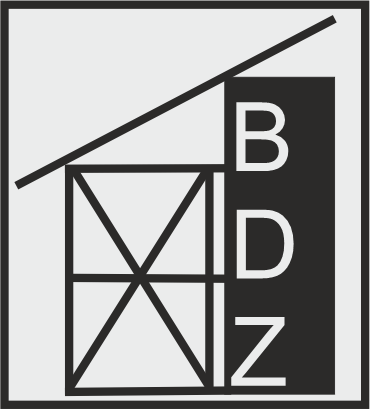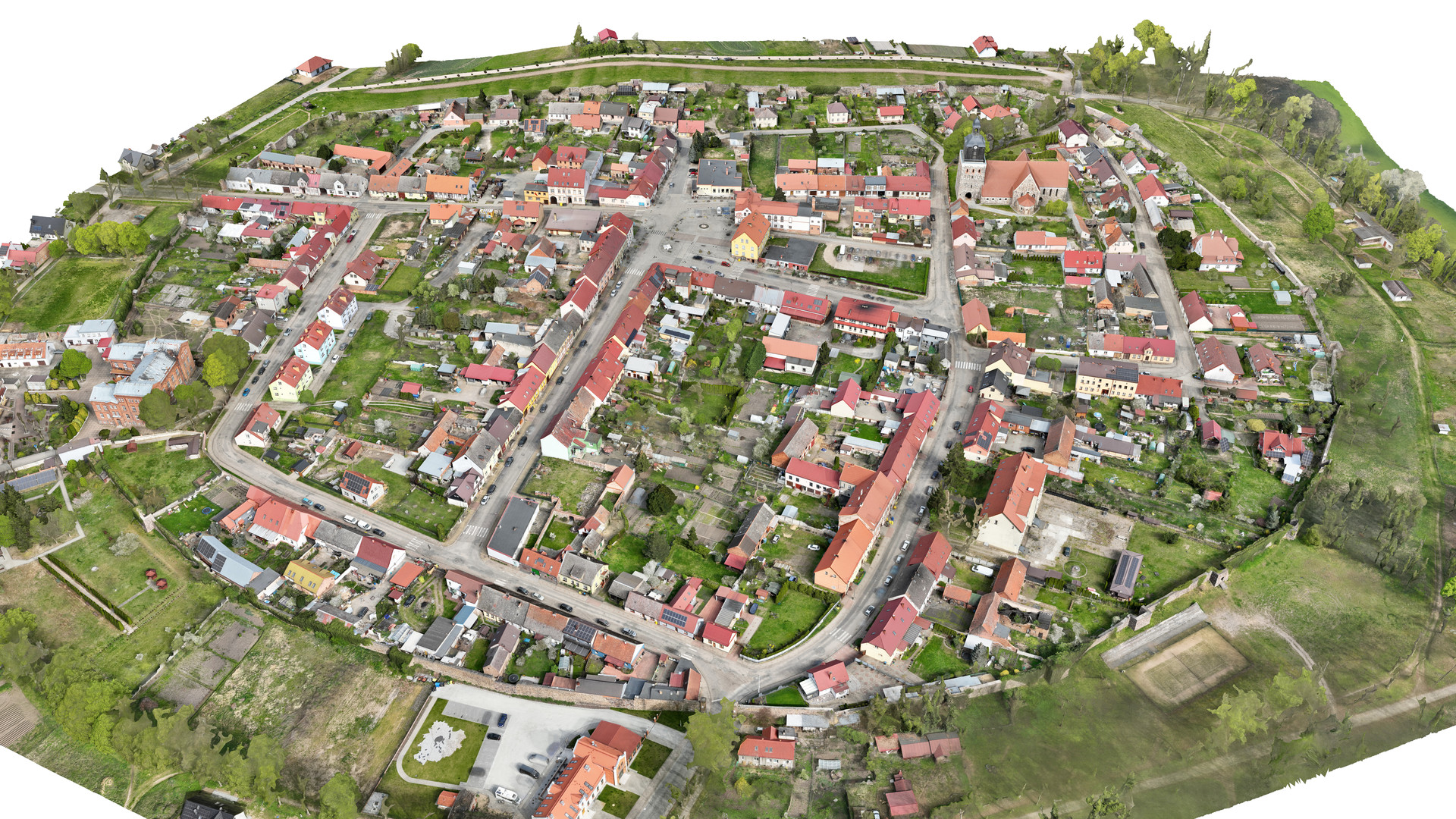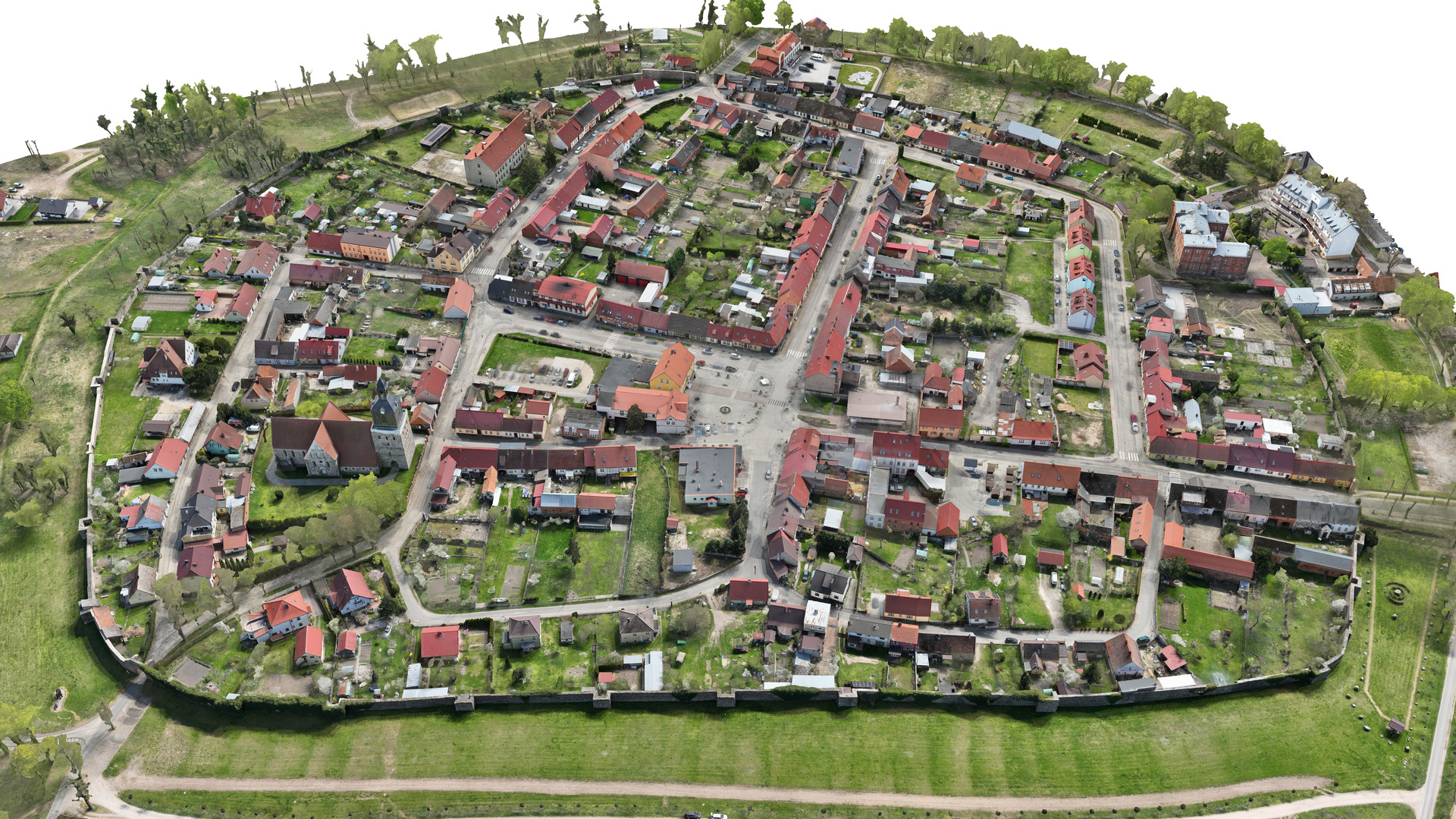MORYŃ - Old town layout
18 listopada 2025
Moryń is a small town located in the south-western part of the West Pomeranian Voivodeship by Lake Morzycko, in a picturesque landscape of moraine hills, fields and forests of the Myślibórz Lake District. Among other similarly-sized towns of the region, it is distinguished by the historical and exposition qualities of its town silhouette.
History
The origins of the town date back to the early Middle Ages. In the 9th – 12th centuries, on the nearby island of Lake Morzycko (now a peninsula, the so-called Castle Mountain), there was a gord (a fortified settlement) belonging to the Cedynia castellania, which was a part of the Duchy of Pomerania. During the 12th century, south of the castle, on the shore of the lake, a settlement with urban features developed: today's eastern part of Moryń. Researchers describe it as an open settlement of a trading character. It had the shape of an oval (on a north-south axis) and functioned as an administrative and service centre for several neighbouring Slavic villages. Around the middle of the 13th century, a church was built in its northern part, first mentioned in historical sources from 1263.
Further urban development of Moryń is related to the rule of the Brandenburg margraves, who in the second half of the 13th century took over the area, creating the New March. The town was founded (according to the rights of the towns of Stendal and Prenzlau in Uckermark) by margrave Otto from the Ascanian dynasty, probably between 1270 and 1306, when the term civitas Morin appeared in the historical sources. The area to the west of the settlement was designated for new housing, with large irregular quarters divided by streets and with a market square in the central part. The town was enclosed by a circle of walls with 32 lookout points (half towers). It was surrounded by an earth rampart and a moat. The town could be entered through two gates with foregates: the Młyńska Gate from the west and the Mieszkowicka Gate from the south, as well as through a water gate (the Jeziorna Gate) from the north.
In the 14th century, Moryń was already a fully formed, economically strong town, as evidenced by a document from 1306 concerning the purchase by the townsfolk of five surrounding lakes from the margraves Otto IV and Waldemar for the price of 16,000 Brandenburg thalers. Around 1350 Moryń had a town council and during the reign of Otto Wittelsbach (1365-1373) the town with its castle was an important political centre.
In years 1402 – 1454, Moryń and the whole New March came under the rule of the Teutonic Order, which started an unfavourable period in the town's history. Hussite raids were destroying it. After the purchase of the New March by the Elector of Brandenburg Friedrich II, the town was ruled by representatives of noble families: Schlabrendorff, Köckeritz and Doberkow. From 1500 onwards, the town was a private property of the Schönebeck family, which was also not encouraging for its development.
Within the following centuries, Moryń, located in a peripheral area away from important transport routes, maintained the character of a provincial agricultural centre, with crop production, retail trade and crafts. The market square (from the end of the 15th century) hosted weekly stall sales and annual horse and cattle fairs. The original medieval buildings were destroyed by numerous fires (in 1637, 1640, 1688, 1746, 1767, 1783). New houses were built in the native timber-frame (half-timbered, post-and-beam) construction, which survived in Moryń until the 3rd quarter of the 19th century, gradually giving way to brick buildings.
In the 19th century, after the agricultural reforms, 147 burghers having their own farms were recorded in Moryń. Significant spatial changes also took place at this time: the town ramparts and moats were levelled and replaced by a walking and viewing avenue. In 1874 an orphanage was built from the foundation of Dr. Christian Friedrich Koch. The market square acquired a new, trapezoid-like shape and buildings. Moryń, taking advantage of its landscape qualities, was gradually transformed into a summer resort. In early 20th century, the streets were paved, the town had a school, a post office and a pharmacy, and two inns were opened at the market square with a new brick town hall. In 1926, a modern bathing facility was created by the lake.
The city was not destroyed in the warfare of 1945. Incorporated into Poland, it was settled by people from the Eastern Territories, as well as from Lesser Poland and Greater Poland. Today, it is the seat of an urban-rural municipality and a constantly developing, attractive holiday and leisure centre, cherishing its history.
Description
The layout of the old town of Moryń, of early-medieval origins, is characterised by an oval, horseshoe-shaped layout (opening towards the north). The most important elements composing the silhouette of the town are the medieval fortifications, the Romanesque-Gothic parish church, the market square with the town hall, the low-rise town houses with internal gardens and the complex of the former foundation of Dr. Ch. F. Koch.
The town is surrounded by almost complete granite stone walls, regularly articulated with the rectangular protrusions of former lookout points. Entrances to the centre are located at the site of the original town gates, on the western and southern sides. Another access leads from the north through the so-called lake gate, originally leading to the knights' castle (former gord).
Inside the area demarcated by the walls, the space is filled with several large quarters of buildings, divided by streets intersecting at right angles and with arched delineation. The central part is occupied by a market square with a town hall. The eastern part of the layout, with the church, is the oldest part of the town reaching back to the time before its foundation: it used to be a trading settlement. Its original spindle-shaped layout, separated by the arrangement of the present Szkolna (former route leading to Mieszkowice and to the castle) and Chopina streets, is still evident.
The massive Romanesque-Gothic building of the church, with its transept and a high tower with a Baroque crowning, has been dominating the town panorama and the surrounding landscape uninterruptedly for centuries. The three-winged historicizing building of the former Dr. Koch orphanage at the opposite end of the town provides a compositional counterweight. Its location in the close vicinity of the walls was connected with the removal of a 100-metre section of the medieval fortifications (still the only cavity in the perimeter of the walls).
The town housing (dating from the 2nd half of the 19th to the 1st quarter of the 20th century) forms frontage lines along the main streets. The houses, mainly single-storey, with several axes, are arranged with their ridges parallel to the streets, and the unity of the composition is emphasised by the uniform gabled roofs. These single-storey houses, typical of Moryń, have hallways in the central axes and gable-end entrances to courtyards, which turn into vegetable gardens which occupy the elongated plots. Household gardens also descend to the line of the town walls at the back parts of the properties situated right beside the walls. The single-storey, tenement-type houses are mainly concentrated around the town square, visually accentuating its importance. Their facades are decorated with modest plaster detailing.
The scarce modern buildings (blocks of flats and pavilions) do not interfere with the exposure of Moryń's architectural and compositional dominants. The historical scale of the houses with gardens in the central parts of the town centre quarters, which has been maintained to this day, is also a reference to and a continuation of the traditional agricultural character of the town, which still retains high cultural and aesthetic values.
Show/hide metadata
| Etykieta | Element Dublin Core | Metadane |
| Tytuł | title | Układ staromiejski w Moryniu |
| Twórca | creator | Biuro Dokumentacji Zabytków w Szczecinie |
| Twórca | creator | Krzysztof Tymbarski |
| Temat | subject | Miasto |
| Temat | subject | Mury obronne |
| Temat | subject | Układ staromiejski |
| Temat | subject | Stare miasto |
| Opis | description | Czas powstania obiektu: między 1270 a 1306 r. |
| Opis | description | Twórca obiektu: --- |
| Opis | description | Materiał obiektu: kamień / drewno / cegła / bruk |
| Opis | description | Technika wykonania obiektu: mur kamienny i ceglany / szachulec |
| Opis | description | Widok modelu miasta z perspektywy ptasiej od strony zachodniej. |
| Wydawca | publisher | Biuro Dokumentacji Zabytków w Szczecinie |
| Data | date | 2025-10-02 |
| Rodzaj | type | image |
| Format | format | image/jpeg |
| Źródło | source | Zbiory cyfrowe Biura Dokumentacji Zabytków w Szczecinie |
| Język | language | pl |
| Zasięg | coverage | Moryń |
| Identyfikator | identifier | https://bdz.szczecin.pl/kc25/moryn-i-trzcinsko-zdroj/moryn-uklad-staromiejski/Moryn-MIASTO-widok-od-zachodu.jpg |
Show/hide metadata
| Etykieta | Element Dublin Core | Metadane |
| Tytuł | title | Układ staromiejski w Moryniu |
| Twórca | creator | Biuro Dokumentacji Zabytków w Szczecinie |
| Twórca | creator | Krzysztof Tymbarski |
| Temat | subject | Miasto |
| Temat | subject | Mury obronne |
| Temat | subject | Układ staromiejski |
| Temat | subject | Stare miasto |
| Opis | description | Czas powstania obiektu: między 1270 a 1306 r. |
| Opis | description | Twórca obiektu: --- |
| Opis | description | Materiał obiektu: kamień / drewno / cegła / bruk |
| Opis | description | Technika wykonania obiektu: mur kamienny i ceglany / szachulec |
| Opis | description | Widok modelu miasta z perspektywy ptasiej od strony wschodniej. |
| Wydawca | publisher | Biuro Dokumentacji Zabytków w Szczecinie |
| Data | date | 2025-10-02 |
| Rodzaj | type | image |
| Format | format | image/jpeg |
| Źródło | source | Zbiory cyfrowe Biura Dokumentacji Zabytków w Szczecinie |
| Język | language | pl |
| Zasięg | coverage | Moryń |
| Identyfikator | identifier | https://bdz.szczecin.pl/kc25/moryn-i-trzcinsko-zdroj/moryn-uklad-staromiejski/Moryn-MIASTO-widok-od-wschodu.jpg |
Show/hide metadata
| Etykieta | Element Dublin Core | Metadane |
| Tytuł | title | Układ staromiejski w Moryniu |
| Twórca | creator | Biuro Dokumentacji Zabytków w Szczecinie |
| Twórca | creator | Krzysztof Tymbarski |
| Temat | subject | Miasto |
| Temat | subject | Mury obronne |
| Temat | subject | Układ staromiejski |
| Temat | subject | Stare miasto |
| Opis | description | Czas powstania obiektu: między 1270 a 1306 r. |
| Opis | description | Twórca obiektu: --- |
| Opis | description | Materiał obiektu: kamień / drewno / cegła / bruk |
| Opis | description | Technika wykonania obiektu: mur kamienny i ceglany / szachulec |
| Opis | description | Widok modelu miasta z perspektywy ptasiej od strony południowej. |
| Wydawca | publisher | Biuro Dokumentacji Zabytków w Szczecinie |
| Data | date | 2025-10-02 |
| Rodzaj | type | image |
| Format | format | image/jpeg |
| Źródło | source | Zbiory cyfrowe Biura Dokumentacji Zabytków w Szczecinie |
| Język | language | pl |
| Zasięg | coverage | Moryń |
| Identyfikator | identifier | https://bdz.szczecin.pl/kc25/moryn-i-trzcinsko-zdroj/moryn-uklad-staromiejski/Moryn-MIASTO-widok-od-poludnia.jpg |
Show/hide metadata
| Etykieta | Element Dublin Core | Metadane |
| Tytuł | title | Układ staromiejski w Moryniu |
| Twórca | creator | Biuro Dokumentacji Zabytków w Szczecinie |
| Twórca | creator | Krzysztof Tymbarski |
| Temat | subject | Miasto |
| Temat | subject | Mury obronne |
| Temat | subject | Układ staromiejski |
| Temat | subject | Stare miasto |
| Opis | description | Czas powstania obiektu: między 1270 a 1306 r. |
| Opis | description | Twórca obiektu: --- |
| Opis | description | Materiał obiektu: kamień / drewno / cegła / bruk |
| Opis | description | Technika wykonania obiektu: mur kamienny i ceglany / szachulec |
| Opis | description | Widok modelu miasta z perspektywy ptasiej od strony północnej. |
| Wydawca | publisher | Biuro Dokumentacji Zabytków w Szczecinie |
| Data | date | 2025-10-02 |
| Rodzaj | type | image |
| Format | format | image/jpeg |
| Źródło | source | Zbiory cyfrowe Biura Dokumentacji Zabytków w Szczecinie |
| Język | language | pl |
| Zasięg | coverage | Moryń |
| Identyfikator | identifier | https://bdz.szczecin.pl/kc25/moryn-i-trzcinsko-zdroj/moryn-uklad-staromiejski/Moryn-MIASTO-widok-od-polnocy.jpg |





























